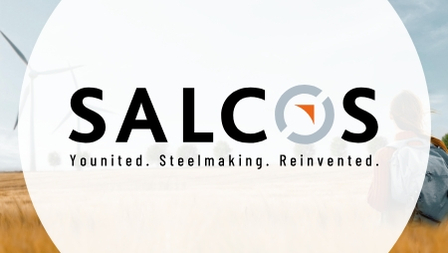Salzgitter and Stahlo: strategic green steel partners
19.05.2022 | Salzgitter Flachstahl GmbH
The steel industry is on the verge of a sea change - indeed, the greatest transformation in its history. The goal: to switch the existing process of producing steel to a procedure that is as climate compatible as possible. The road map is an ambitious one. As the very first steel producer ever, the Salzgitter Group intends to replace all three of its blast furnaces by what are known as direct reduction plants over the period up until 2033. These facilities would then be operated using natural gas and hydrogen instead of coal. The first direct reduction plant is due to go online in 2026.
Incrementally switching production to hydrogen direct reduction
Switching this previous method of production that has been developed close to the limits of what science and technology permits to the new technology represents a huge challenge. “Producing pig iron from iron ore using the direct reduction procedure is completely different from the blast furnace route,” explains Phillip Meiser, Sales Director at Salzgitter Flachstahl GmbH. “This is why the transformation will be gradually made through to 2033, allowing us to ensure supply reliability for our customers and continuous operations.” Instead of coking coal in the blast furnace, iron ore will then be converted into pig iron by harnessing hydrogen in the future. The direct reduction plants that are home to this process will then no longer emit CO2 but only water vapor. This procedure opens up the possibility for steel production to become entirely “green”.
Green steel production needs “green” electricity and massive investment
A precondition for this undertaking is having sufficient “green” hydrogen, i.e. produced free of CO2. In turn, having “green” hydrogen necessitates green electricity, meaning power sourced from renewable energies. With this in mind, Salzgitter AG has entered into a strategic partnership with Danish energy company Ørsted, among others. Ørsted is one of the green market leaders in planning, building and operating offshore wind farms. “We need sufficient energy for the hydrogen-based production of steel. Offshore wind farms can generate enough green energy and make it available to us,” as Phillip Meiser explained. “This will require completely new infrastructure, however.” Just like the entire industrial arena that is subject to the same transformation process, steel producers need support not only in building a new infrastructure but also in terms of the necessary investments. Phillip Meiser went on to comment: “Switching to carbon-neutral production will cost around three to four billion euros. Salzgitter AG is unable to foot the costs all by itself. Consequently, we also need public subsidies,”

The challenge is scaling up for industrial use
For some time now, the company has been actively paving the way for low-emission production under its SALCOS project (stands for SAlzgitter Low CO2 Steelmaking). “We will be able to reduce the emissions by more than 95 % compared with the current status, which will take us very close to zero emission production,” as Maik Lintl, Head of Sales at Salzgitter Flachstahl GmbH emphasized. All innovation notwithstanding: The necessary technologies are already available in their separate parts. The challenge consists rather more of fusing them together and scaling them up to a production level that has never been realized before. The chances of success are good in terms of technology. This is only one side of the coin, however, – the other is the markets. “We see a huge demand for green steel. But it is clear that steel produced by direct reduction will initially cost more,” Maik Lintl adds.
![CO2-reduced steel from Salzgitter [Translate to Englisch:]Photo of a coil on a crane, which with a special packaging.](/fileadmin/footage/MEDIA/presse/szfg/Kategorien/Gruener-Stahl-Coil-Verladung-448x254.jpg)
First adjustments in the market
Along with the technical production processes, the markets also need to adjust to ensure that this sea change is successful. Steel processors are faced with the challenge that, without the packaging, no one can tell the difference between “conventional” steel and steel produced with a low carbon footprint. They have to be able to rely on the information they are given on the steel product by producers and suppliers and compare this information across producers and suppliers.
Actual CO2: How much and where?
With regard to green steel, one producer – take Salzgitter AG (in the future) for example – is backed by the genuine transformation of the entire steel producing process, while another balances out emissions via CO2 allowances, and the third produces exclusively from steel scrap in a power-driven electrical process. For steel producers, however, the plethora of methods and terminology presents some difficulties. What product involves how much CO2? Steel processors will be looking for answers to this question in the future. A first response is now obtainable from the Stahlo Steel Service Center, a member company of the Friedhelm Loh Group. Already a long-standing partner of Salzgitter Flachstahl, the two companies are also working together strategically on the issue of “green” steel. At an early stage, Stahlo had already recognized the transformation of steel production as a key strategic topic. The company began to think specifically about what the market and its customers would have to deal with if the demand for green steel were to grow. “We consider Stahlo as one of the most significant steel service centers in Germany operating independently of steelworks and an important strategic partner for us, also in terms of green steel,” Phillip Meiser states.
You can read the full article in the betop Magazin of the Friedrich Loh Group.







